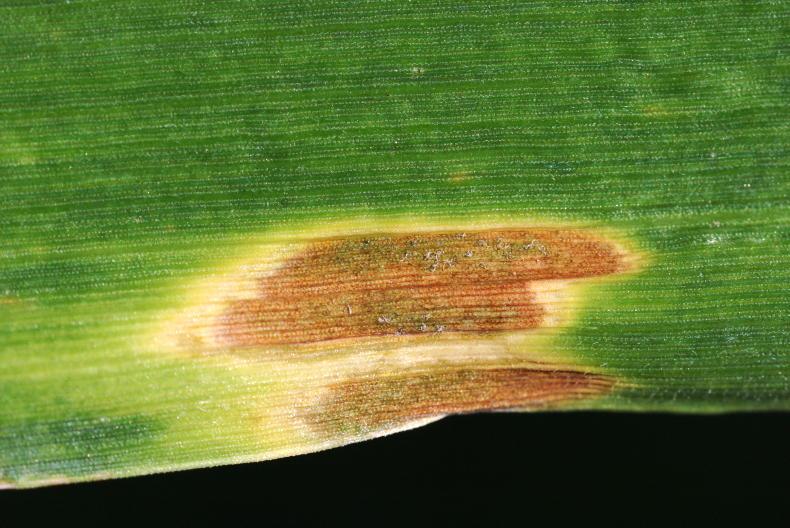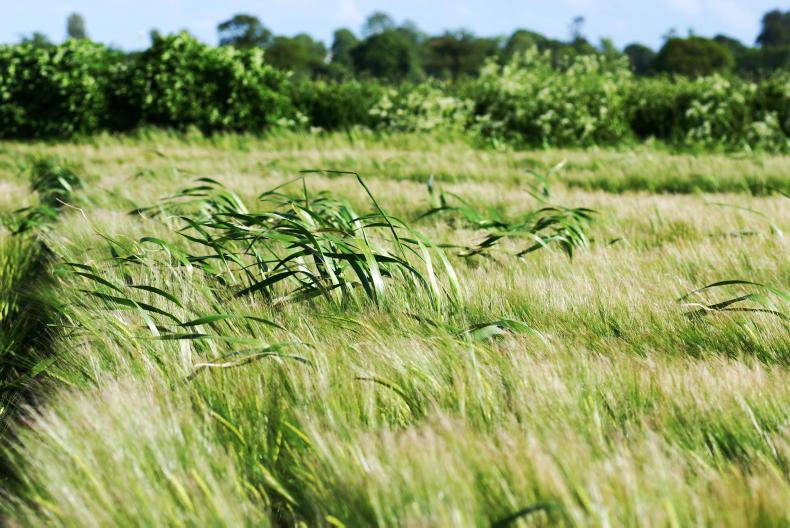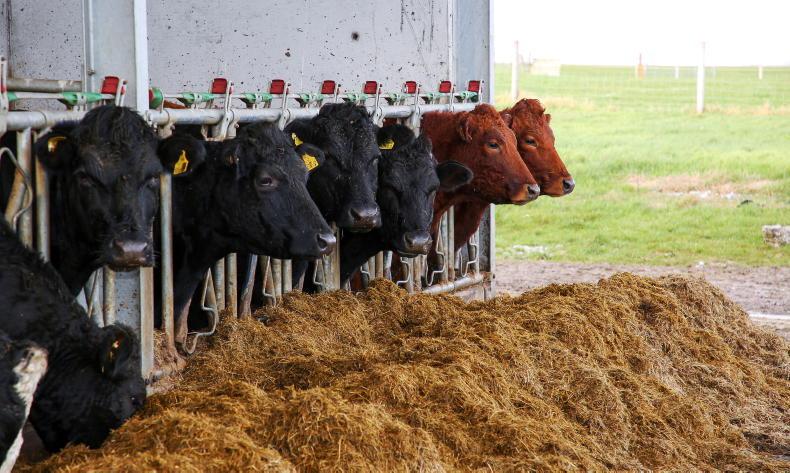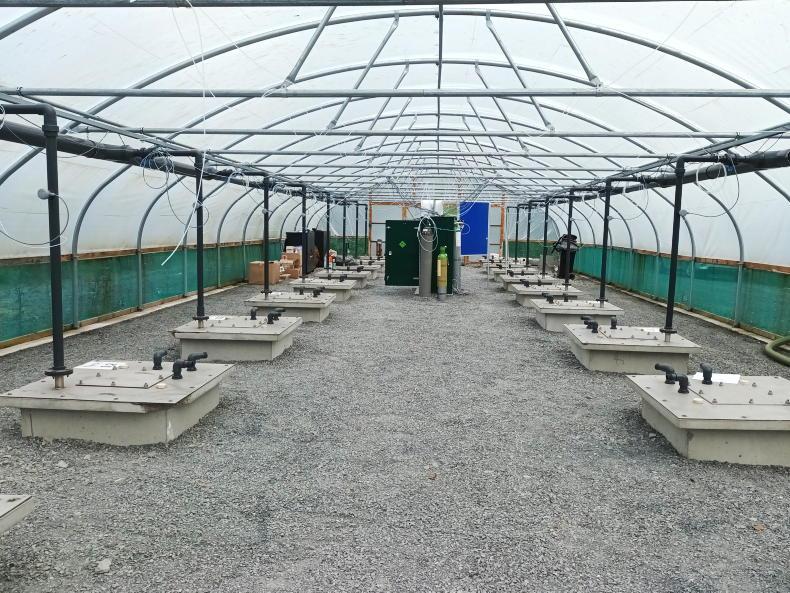Lowering septoria pressure, increasing disease resistance and the benefits of rotation were among the topics at last week’s online tillage conference.
Research is telling us that homegrown resistance in grassweeds continues to increase, winter barley copes less well with a strip-till system than other cereals, wheat yields benefit from rotation and an increasing understanding of the basis of genetic resistance against septoria adds further cause for concern.
Pulling down septoria pressure
Septoria continues to be a major challenge for wheat production and fungicide efficacy. Steven Kildea explained the importance of integrated pest management (IPM) to help reduce infection pressure from septoria or any other disease.

A septoria lesion showing strings of pycnidiospores exuding from the pycnidia.
Septoria seems to be ever-present in our environment and it moves around in the air as small wind-blown ascospores to infect emerging crops. The levels of these spores are much higher early in the season (verified here in ongoing research) so early-sown crops get higher infection loadings. This infection can then cycle a few times in a crop ahead of spring growth, adding to pressure on fungicides.
Variety resistance
Variety resistance is key to slowing disease development but the varieties we grow have only moderate resistance. Our recommended list system evaluates disease resistance and provides a good guide to the risk associated with individual varieties.
However, recent research has confirmed that resistance ratings are effectively decreased with earlier sowing. This lowering of the resistance rating can vary from half a point for a rating of five to more than one point for a rating of seven when sown in mid-September versus mid-October.
Genetic resistance can suffer the same fate as fungicide resistance
Steven reported new findings around septoria isolates that have overcome single gene resistance in specific varieties. This work showed that when Cellule (had strong single gene resistance) broke down to septoria, very specific gene-associated isolates were responsible. When new Cellule plants were infected with these isolates, they were highly susceptible but the plants remained resistant to isolates from Costello. Genetic resistance can suffer the same fate as fungicide resistance.
Isolates target genes
Steven outlined other work that revealed similar issues with varieties that previously had strong septoria resistance. He assessed a number of new varieties using isolates that had cracked Cougar resistance and found that many of these succumbed to this specific isolate. Some of these new varieties were considered to have good septoria resistance but they succumbed to this isolate. Some had Cougar in their parentage – others did not.
This finding emphasises the importance of understanding the basis of genetic resistance in varieties so that we are aware of any potential vulnerability in the face of what appears to be good genetic resistance. It also emphasises the need for a multi-layered approach to genetic resistance that can consistently slow disease development and ease the pressure on fungicides.
Grassweeds herbicide resistance on the spread
Teagasc researcher Vijaya Bhaskar outlined some of the results from his work to determine the level of resistance to herbicides in Irish grassweed populations. This short report focuses on wild oats and brome, as blackgrass resistance will be covered in detail in the Irish Farmers Journal and Teagasc blackgrass series.
Wild oats
Spring germinating wild oats is well known to all tillage farmers. Vijaya collected six wild oat populations from problem fields across Kilkenny, Wexford and Cork.
The samples were grown in a glass house and sprayed at the three-to-four leaf stage with the ACCase herbicides Axial, Falcon and Stratus Ultra using 0.25 to eight times the recommended field rates.

Wild oats have developed tolerance and resistance to up three herbicides in some fields.
Less than 50% control was regarded as below an acceptable level and would facilitate resistance development.
Where Axial was applied, five of the six populations required between 1.4 to 1.7 times the recommended rate to control over 50% of the plants. This confirms that these populations are resistant to Axial.
It took two- to eight-times the recommended rate to control over 50% of the populations when treated with Falcon, again confirming resistance.
Straus Ultra was only effective in controlling two of the six populations tested. One population collected was extremely resistant, recording 100 % survival when treated with 8 times the recommended field rate. However, the ALS herbicide Pacifica Plus at recommended field rate was found to be effective on all six ACCase-resistant populations.
Brome species
Vijaya collected 18 brome populations randomly across the main south-east tillage counties. The samples were grown in a controlled glasshouse and sprayed at the two-to-three leaf stage, with half and full recommended field rates of the ACCase herbicides, Falcon and Stratus Ultra, and the ALS inhibiting herbicides Pacifica Plus and Broadway Star.
Populations with a survival rate above 20% were considered to have evolving herbicide tolerance. He found that 89% of populations treated with half-rate Pacifica Plus had some level of plant survival, ranging from 8 to 68%.
Vijaya’s work shows that wild oat cross-resistance to ACCase herbicides and evolving brome tolerance to ALS herbicides is present but is variable
Even at a full rate of Pacifica Plus, 56 % of these populations showed some level of survival, indicating increasing tolerance or early stage of resistance evolution. However, Falcon, Broadway Star and Stratus Ultra were found to be effective on all populations at full rates.
Vijaya’s work shows that wild oat cross-resistance to ACCase herbicides and evolving brome tolerance to ALS herbicides is present but is variable. Therefore, growers need to maximise the non-chemical control methods available to them and to apply full rates when using herbicides.
Lowering septoria pressure, increasing disease resistance and the benefits of rotation were among the topics at last week’s online tillage conference.
Research is telling us that homegrown resistance in grassweeds continues to increase, winter barley copes less well with a strip-till system than other cereals, wheat yields benefit from rotation and an increasing understanding of the basis of genetic resistance against septoria adds further cause for concern.
Pulling down septoria pressure
Septoria continues to be a major challenge for wheat production and fungicide efficacy. Steven Kildea explained the importance of integrated pest management (IPM) to help reduce infection pressure from septoria or any other disease.

A septoria lesion showing strings of pycnidiospores exuding from the pycnidia.
Septoria seems to be ever-present in our environment and it moves around in the air as small wind-blown ascospores to infect emerging crops. The levels of these spores are much higher early in the season (verified here in ongoing research) so early-sown crops get higher infection loadings. This infection can then cycle a few times in a crop ahead of spring growth, adding to pressure on fungicides.
Variety resistance
Variety resistance is key to slowing disease development but the varieties we grow have only moderate resistance. Our recommended list system evaluates disease resistance and provides a good guide to the risk associated with individual varieties.
However, recent research has confirmed that resistance ratings are effectively decreased with earlier sowing. This lowering of the resistance rating can vary from half a point for a rating of five to more than one point for a rating of seven when sown in mid-September versus mid-October.
Genetic resistance can suffer the same fate as fungicide resistance
Steven reported new findings around septoria isolates that have overcome single gene resistance in specific varieties. This work showed that when Cellule (had strong single gene resistance) broke down to septoria, very specific gene-associated isolates were responsible. When new Cellule plants were infected with these isolates, they were highly susceptible but the plants remained resistant to isolates from Costello. Genetic resistance can suffer the same fate as fungicide resistance.
Isolates target genes
Steven outlined other work that revealed similar issues with varieties that previously had strong septoria resistance. He assessed a number of new varieties using isolates that had cracked Cougar resistance and found that many of these succumbed to this specific isolate. Some of these new varieties were considered to have good septoria resistance but they succumbed to this isolate. Some had Cougar in their parentage – others did not.
This finding emphasises the importance of understanding the basis of genetic resistance in varieties so that we are aware of any potential vulnerability in the face of what appears to be good genetic resistance. It also emphasises the need for a multi-layered approach to genetic resistance that can consistently slow disease development and ease the pressure on fungicides.
Grassweeds herbicide resistance on the spread
Teagasc researcher Vijaya Bhaskar outlined some of the results from his work to determine the level of resistance to herbicides in Irish grassweed populations. This short report focuses on wild oats and brome, as blackgrass resistance will be covered in detail in the Irish Farmers Journal and Teagasc blackgrass series.
Wild oats
Spring germinating wild oats is well known to all tillage farmers. Vijaya collected six wild oat populations from problem fields across Kilkenny, Wexford and Cork.
The samples were grown in a glass house and sprayed at the three-to-four leaf stage with the ACCase herbicides Axial, Falcon and Stratus Ultra using 0.25 to eight times the recommended field rates.

Wild oats have developed tolerance and resistance to up three herbicides in some fields.
Less than 50% control was regarded as below an acceptable level and would facilitate resistance development.
Where Axial was applied, five of the six populations required between 1.4 to 1.7 times the recommended rate to control over 50% of the plants. This confirms that these populations are resistant to Axial.
It took two- to eight-times the recommended rate to control over 50% of the populations when treated with Falcon, again confirming resistance.
Straus Ultra was only effective in controlling two of the six populations tested. One population collected was extremely resistant, recording 100 % survival when treated with 8 times the recommended field rate. However, the ALS herbicide Pacifica Plus at recommended field rate was found to be effective on all six ACCase-resistant populations.
Brome species
Vijaya collected 18 brome populations randomly across the main south-east tillage counties. The samples were grown in a controlled glasshouse and sprayed at the two-to-three leaf stage, with half and full recommended field rates of the ACCase herbicides, Falcon and Stratus Ultra, and the ALS inhibiting herbicides Pacifica Plus and Broadway Star.
Populations with a survival rate above 20% were considered to have evolving herbicide tolerance. He found that 89% of populations treated with half-rate Pacifica Plus had some level of plant survival, ranging from 8 to 68%.
Vijaya’s work shows that wild oat cross-resistance to ACCase herbicides and evolving brome tolerance to ALS herbicides is present but is variable
Even at a full rate of Pacifica Plus, 56 % of these populations showed some level of survival, indicating increasing tolerance or early stage of resistance evolution. However, Falcon, Broadway Star and Stratus Ultra were found to be effective on all populations at full rates.
Vijaya’s work shows that wild oat cross-resistance to ACCase herbicides and evolving brome tolerance to ALS herbicides is present but is variable. Therefore, growers need to maximise the non-chemical control methods available to them and to apply full rates when using herbicides.












SHARING OPTIONS